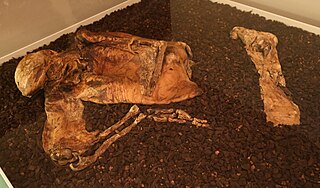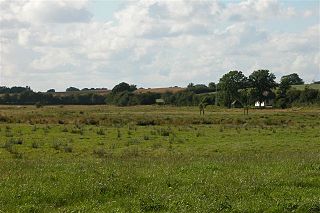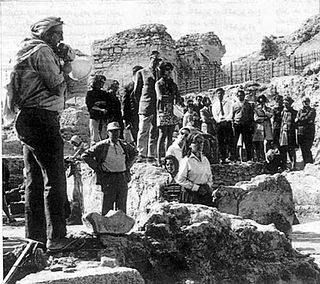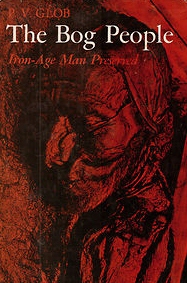Related Research Articles

Lindow Man, also known as Lindow II and as Pete Marsh, is the preserved bog body of a man discovered in a peat bog at Lindow Moss near Wilmslow in Cheshire, North West England. The remains were found on 1 August 1984 by commercial peat cutters. Lindow Man is not the only bog body to have been found in the moss; Lindow Woman was discovered the year before, and other body parts have also been recovered. The find was described as "one of the most significant archaeological discoveries of the 1980s" and caused a media sensation. It helped invigorate the study of British bog bodies, which had previously been neglected.

A bog body is a human cadaver that has been naturally mummified in a peat bog. Such bodies, sometimes known as bog people, are both geographically and chronologically widespread, having been dated to between 8000 BC and the Second World War. The unifying factor of the bog bodies is that they have been found in peat and are partially preserved; however, the actual levels of preservation vary widely from perfectly preserved to mere skeletons.
Below are notable events in archaeology that occurred in 1865.
Below are notable events in archaeology that occurred in 1922.
Below are notable events in archaeology that occurred in 1939.
Below are notable events in archaeology that occurred in 1900.
The year 1994 in archaeology involved some significant events.
The year 1956 in archaeology involved some significant events.
The year 1958 in archaeology involved some significant events.
The year 1954 in archaeology involved some significant events.

The Grauballe Man is a bog body that was uncovered in 1952 from a peat bog near the village of Grauballe in Jutland, Denmark. The body is that of a man dating from the late 3rd century BC, during the early Germanic Iron Age. Based on the evidence of his wounds, he was most likely killed by having his throat slit. His corpse was then deposited in the bog, where his body was naturally preserved for over two millennia. His was not the only bog body to be found in the peat bogs of Jutland. Together with other notable examples, Tollund Man and the Elling Woman, Grauballe Man represents an established tradition at the time. It is commonly thought that these killings, including that of Grauballe Man, were examples of human sacrifice, possibly an important rite in Iron Age Germanic paganism.

The Haraldskær Woman is the name given to a bog body of a woman preserved in a bog in Jutland, Denmark, and dating from about 490 BC. Workers found the body in 1835 while excavating peat on the Haraldskær Estate. The anaerobic conditions and acids of the peat bog contributed to the body's excellent preservation. Not only was the intact skeleton found, but so were the skin and internal organs. Scientists settled disputes about the age and identity of this well-preserved body in 1977, when radiocarbon dating determined conclusively that the woman's death occurred around the 5th century BC.

The Nydam Mose, also known as Nydam Bog, is an archaeological site located at Øster Sottrup, a town located in Sundeved, eight kilometres (5 mi) from Sønderborg, Denmark.

Windeby I is the name given to the bog body found preserved in a peat bog near Windeby, Northern Germany, in 1952. Until recently, the body was also called the Windeby Girl, since an archaeologist believed it to be the body of a 14-year-old girl, because of its slight build. Professor Heather Gill-Robinson, a Canadian anthropologist and pathologist, used DNA testing to show the body was actually that of a sixteen-year-old boy. The body has been radiocarbon-dated to between 41 BC and 118 AD.

Moesgaard Museum (MOMU) is a Danish regional museum dedicated to archaeology and ethnography. It is located in Beder, a suburb of Aarhus, Denmark.

Thomas Geoffrey Bibby was an English-born archaeologist. He is best known for discovering the ancient state of Dilmun, referred to in Mesopotamian mythology as a paradise. He is often considered to have been the pioneer of Arabian archaeology.

Osterby Man or the Osterby Head is a bog body of which only the skull and hair survived. It was discovered in 1948 by peat cutters to the southeast of Osterby, Germany. The hair is tied in a Suebian knot. The head is at the State Archaeological Museum at Gottorf Castle in Schleswig, Schleswig-Holstein.

The Bog People: Iron-Age Man Preserved is an archaeological study of the bog bodies of Northern Europe written by the Danish archaeologist P.V. Glob. First published in 1965 by Gyldendal under the Danish title of Mosefolket: Jernalderens Mennesker bevaret i 2000 År, it was translated into English by the English archaeologist Rupert Bruce-Mitford and published by Faber and Faber in 1969. In 1966 it was translated into German by Thyra Dohrenburg and published by Winkler Verlag Munich under the title Die Schläfer im Moor.
Karl Schlabow was a German archaeologist, museum director and conservator with specialisations in textiles and in restoration of bog bodies. He founded the Neumünster Textile Museum. Since his death, his restorations have been called into question as overly aggressive.
References
- ↑ Gill-Robinson, Heather Catherine (2006). The iron age bog bodies of the Archaeologisches Landesmuseum, Schloss Gottorf, Schleswig, Germany. Manitoba: University of Manitoba. ISBN 9780494122594. (Doctors thesis)
- ↑ Foreword to Asingh., Pauline; Lynnerup, Niels (2007). Grauballe man: An Iron Age bog body revisited. Aarhus: Aarhus University press. ISBN 978-87-88415-29-2.
- ↑ "Cracking the code: the decipherment of Linear B 60 years on". University of Cambridge. 13 October 2012. Retrieved 2 June 2017.
- ↑ "Alan Vince - Obituary". The Guardian. 28 April 2009. Retrieved 7 June 2017.
- ↑ "Foucher, A. (Alfred) 1865-1952". worldcat.org. Retrieved 2 June 2017.